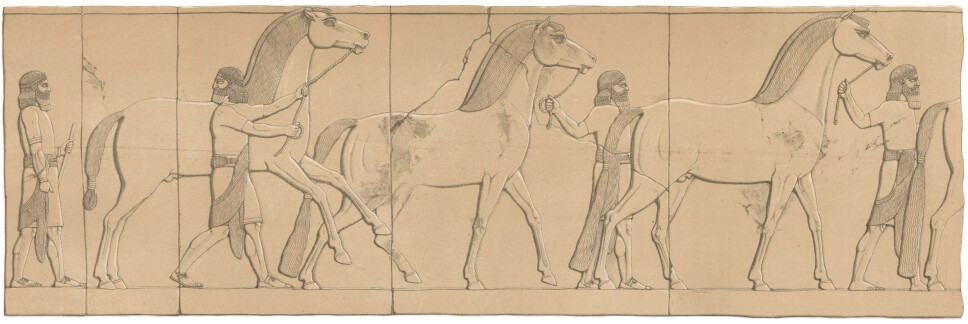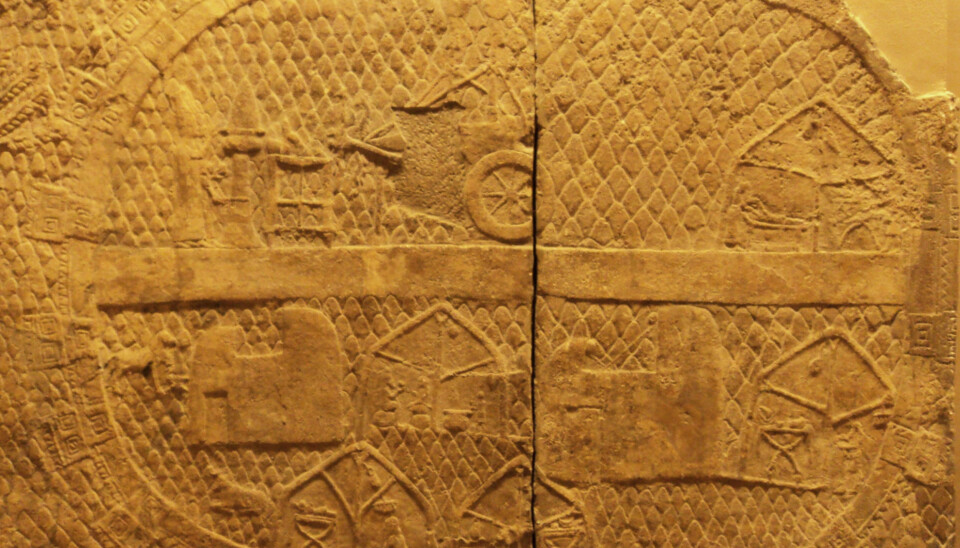Researchers' Zone:

Epidemics in the cradle of civilization
Social distancing and isolation were present as means to combat epidemics then as now.
Epidemics are like ebb and flow, they come and go over time. While COVID-19 is the latest leaf on this particular weed in the prosperous garden of medical history, it definitely is not the first.
When people in ancient Mesopotamia (modern day Iraq and Syria) built the world’s first metropolises in the 4th and 3rd millennium BCE, the spread of infections was accelerated to a hitherto unknown degree.
Earlier contact had largely been characterized by occasional interactions between smaller and rural communities, but with the rise of great cities, people began living closely together and were more dependent upon one another.
Society was suddenly in a state of constant physical and social interaction.
It is therefore no wonder that the written sources from Mesopotamia provide the first written references to epidemics in world history.
In the following, I will exemplify what information some of the earliest written sources in existence provide about epidemic outbreaks in ancient Mesopotamia, how people attempted to avoid and contain infectious diseases, and what perspectives their experiences might offer us.

Infection advice on clay tablets
An epidemic in ancient Mesopotamia was simply called ‘cases of death’, although there existed a number of associated terms, which are translated as ‘plague’ and ‘pestilence’.
Among the tens-of-thousands inscribed clay tablets from around especially ca. 2.000 BCE to 0 CE, we find an abundance of information concerning the actions people took against epidemics.
The preventive rituals against such fearsome phenomena bear witness to regular and widespread infections among humans and animals, and they must have affected entire cities, animal enclosures, as well as military camps.
Seized by an angry deity
According to the textual sources, gods regularly caused disease by touching, seizing, devouring or hitting the unfortunate. Illness literally had a hold of the patient in Mesopotamia.
Therefore, suffering was regularly perceived as having been sent by an angry deity, and specific gods were responsible for some diseases.
However, ailments also had concrete physiological symptoms of various kinds. Consequently, one could treat some diseases by alleviating the physical symptoms with soothing herbs and medications, while it was possible to appease the deity responsible for the illness with rituals and prayers.
Other aspects of medicine, however, seem to have focused on pragmatic knowledge of plants and herbs, alongside general ideas of how to treat or avoid infection.
Still, the distinction made today between purely medical and magical forms of treatment was virtually non-existent in Mesopotamia.

We know a handful of ancient specialists who acted as the primary healing professions. Although their duties changed over the millennia, individual experts were able to predict, prevent or cure diseases and ailments, as well as interpret omens.
The textbooks of such professionals, alongside private letters and other documents, form the basis for our reconstruction of Mesopotamian medicine.
Contagion kept at bay via isolation
Societies in ancient Mesopotamia had an idea of contagion, although it was not rooted in a modern medical understanding of infection.
We find several examples in a series of letters from around 1775 BCE excavated in a palace in the western Syrian city Mari by the river Euphrates.
In one letter, the king Zimri-Lim wrote to queen Shibtum about a woman at court who had taken ill, although she continued to socialise with other women in the palace.
The instruction was clear, and it ordered both social distancing and isolation:
»Now give strict orders, and (make sure) no one drinks of the cup, from which she drinks, no one sits on the chair, on which she sits, and that no one sleeps on the bed, upon which she sleeps. She should not gather (these) many women about herself!« (Archives royales de Mari 10 no. 129 lines 10-19).
Behind such reasoning lay the basic experience that illness could be transmitted either through physical intimacy or via personal belongings. However, this also applied to other kinds of suffering, which were not contagious in a modern medical sense.
Isolation of entire cities and soldiers
We know from several sources that it was normal practice to seal off cities affected by an epidemic. Some incantations even indicate that it was possible to prevent ‘cases of death’ in an entire city via the use of a ritual, which culminated in the burning of a brush pile.
Whether or not this incineration was an act of purification, or a means to handle large amounts of casualties, remains unknown. However, in a letter from ca. 1800 BCE, the Assyrian king Shamshi-Adad ordered his son Yasmah-Addu to isolate and confine a group of ill soldiers and burn their armour in a temple in the city Ekallatum in the northern part of Iraq.
From later periods, it seems that fumigation was also employed as a measure against contagion. Therefore, concrete actions could be sought out to treat the individual, but tangible initiatives also existed designed to protect a city or perhaps even the entire state.
Perhaps as a result of past experiences, lists of various omens contain condensed wisdom related to outbreaks of disease. For example, one ill omen foreshadows that »there will be a severe epidemic and one brother will not enter the house of another brother« (Shumma izbu OB version paragraph 38).
‘A god touched my sheep’
Animals throughout history likely had a share in the spread and development of infectious viruses and bacteria, which could be transmitted from animals to humans (zoonosis).
People in ancient Mesopotamia lived closely together with their animals, and some animals, such as cows, had human names. Even in tightly packed military camps people lived alongside horses and other animals in compact surroundings.
Today, we know a series of terms for animal diseases from Mesopotamia, and many are similar to the names known for human illnesses. It therefore seems that particularly recognizable symptoms or characteristics of an ailment, which appeared in animals and humans alike, formed the basis for associating these diseases with each other.

From time to time, entire flocks of animals were afflicted with diseases, presumably because they were in close contact. In a letter from ca. 1745 BCE, a certain Niqmi-Adad wrote to a regent called Till-Abnû of the northern Iraqi city Shekhna concerning a flock of sheep, which he had to lead to another city.
However, when he was about to lead the animals on their way »a god touched my sheep (i.e., they became ill), and until I restored the relationship with the deity, I held the sheep back with me« (The Royal Archives from Tell Leilan no. 85 lines 13-16).
Quarantine with magical figures
Certain rituals were intended to protect households from epidemics. Especially two ceremonies were designed »to block (the entry of) ‘the foot of evil’ into a man’s house« and »to avert pestilence, plague and epidemic« (KAR 298).

Such rites contain lengthy instructions and incantations for the preparation of various figurines and divine beings, which were subsequently buried in central spaces in the house, for example, underneath thresholds. These would ensure that no evil could find a foothold in the house.
However, when evil sometimes made its way into a man’s house anyway, for example, by hiding in his shadow, it was possible for a healer to perform the ritual »The house of confinement« (Bit meseri) or to utter the text »The house is put under a spell« (Tummu bitu).
Particularly ‘The house of confinement’ focused on producing magical figurines and drawings on the walls of various rooms in the house, first in the bedroom where the patient was located, and subsequently in other rooms.
Ultimately, protective spirits were drawn at the main entrance. In practice, such magical means functioned as a sort of quarantine, in the sense that they enclosed the patient, as well as marked off his or her home so that others could see they should avoid it.
Military camps as breeding grounds for diseases
Finally, we must not forget the act of war, seeing as the aftermath of such aggressions, then as now, usually includes spread of infectious diseases. War was for long periods a term of life in ancient societies, and some of history’s earliest armed conflicts can be traced to Mesopotamia.
Particularly the aftermath of individual battles or entire campaigns, as well as the ensuing destruction, must have constituted perfect breeding grounds for epidemics. Perhaps as an attempt to slow or halt the spread of infection, the dead were occasionally buried in a burial mound after battles.
Sieges of cities must also have provided a solid basis for illness. When the Assyrian king Sennacherib laid siege to Jerusalem in 701 BCE, he anticipated a victory over Jerusalem’s king Hezekiah.
Sadly for Sennacherib, something went wrong.
The Assyrian account informs us that Hezekiah simply paid a lavish tribute, after which the Assyrians went home. The Old Testament account, however, describes how an angel of the Lord went through the Assyrian camp one night, and killed countless soldiers (The Old Testament, 2 Kings 19:31ff.).
The truth is probably found somewhere in between, and some researchers today believe that the Assyrian army experienced an outbreak of an infectious disease. Precisely this fear for infectious outbreaks in military camps is reflected in a number of elaborate rituals designed to keep disease out of such temporary and tightly packed dwellings.

Comparing the ancient experience to our own
Epidemics have always played a part in the progress of humanity, and ancient Mesopotamia was no exception. The above draws primarily on sources from ca. 2000 BCE – 0 CE, and I have used these to very generally describe how people in Mesopotamia faced, treated and survived epidemics in ancient times.
But how does the Mesopotamian experience of epidemics compare to our own?
Today, we have a wide range of historical documentation and scientific models available to help us guide society. Sadly, we are in some regards not better off than the ancients.
We rely on prognostication, same as they, and although our methods are based on science, the development of the COVID-19 crisis has laid bare the problems of an unprepared society.
Though people in ancient Mesopotamian did not produce detailed observational data of epidemics, wisdom gained from such horrific events likely dated back several millennia.
Nevertheless, it seems the value of such scattered insights was limited to overarching responses, such as lock-down measures and isolation. Today, in the case of COVID-19, these particular actions have been the initial means as well.
Changing relationship to death
Anthropological research has shown that epidemics throughout past centuries have induced fear of contamination, stigmatization, and apocalyptic experiences in various societies (for example Herring and Swedlund (eds.) 2010, Plagues and Epidemics, pp. 4-5).
Several of these responses seems almost universal, and many people who lived through such crises must have invoked the question: ‘Why me?’ At least to this end, the healing systems in ancient Mesopotamia could provide concrete actions designed to deal with similar feelings and questions.
However, one of the most crucial differences between the ancients and us must be our relationship to death. Today, western societies have removed death as much as possible from daily life. While focusing on continuously prolonging life, death has been relegated to a few key institutions.
Only a century ago, death was still part of everyday life, and in ancient Mesopotamia it was a daily reality for families, especially due to a higher child mortality rate and a lower life expectancy.
Nonetheless, people in Mesopotamia seem to have continuously attempted to predict and circumvent the onset of infectious diseases. And in times of crisis, the ancient specialists utilized the best means available to them in an attempt to halt the spread of infection.






